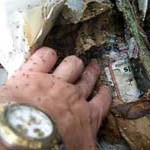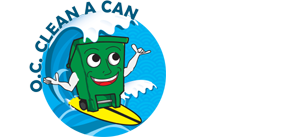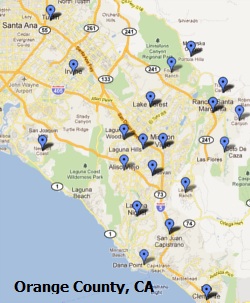

Especially during the summer months, those trash containers that you wheel to the curbside each week may attract some unwanted pests such as ants, which can be a particularly difficult problem. The small black Argentine ants that are most common in California are sometimes hard to get rid of. Like most other ant species, they nest underground and are attracted to sweet food. If you find just a few ants crawling on the trash can, in no time, these scouts will summon hundreds more to feast upon the contents. When ants discover food, they leave a scented trail for others to follow.
First Line of Defense
First, address what’s primarily attracting the ants. You cannot deny ants a feast within your trash can unless you are proactive. The best way is to eliminate their access to food and water.
Trash cans should be emptied weekly whether they are full or not. Empty trash cans will deprive the ants of their food source for a couple of days. Of course, this is not true for “dirty” trash cans. Dirty cans will consistently provide a place for the ants to feed.
Add a generous sprinkle of ground cloves around the can as cloves are a great ant repellant, which spiders also detest.
Put caps back on bottles where possible, corks in wine bottles, etc. Rinse out containers that contained a sugary product such as soda cans and ice cream cartons.
To contain the scent, put ant-attractive food items like candy wrappers, microwave popcorn bags, cereal bags, etc. in tightly sealed plastic bags and don’t fill the trash can to the extent its lid will not close completely.
Don’t smash the trash down to shove more in as this can tear the bags and expose the food items that you carefully sealed.
Eliminate a water source by not disposing of liquids into the trash container.
If your trash cans are kept on a paving material, check for cracks and repair them with caulking as needed. Ants like to nest in cracks.
Ants are attracted to plants that support large populations of honeydew-producing insects such as aphids and whiteflies. Avoid placing trash cans near such trees and shrubs. If the sticky, honeydew substance has dripped onto the trash can, remove it promptly with a mixture of 2 tablespoons of vinegar in a gallon of water.
Replace damaged trash cans, which allow ants an easy access to the contents. Trash haulers in Orange County typically do not charge a fee to replace broken containers.
Keep the cans clean. OC Clean A Can will clean them monthly right at your curbside. We use a non-toxic, EPA registered, citrus-based disinfectant, which keeps them clean and sanitized.
Treat the Invasion
Secondly, you need to kill them by spraying the ants with a soapy detergent, such as Simple Green. Remove the carcasses and erase the chemical trail that the ants have laid down by using a concentrated citrus-based cleaner or vinegar. Apply it to the cans and the surrounding area. Next, establish a barrier around the cans. Diatomaceous earth can be used as a barrier, and many people have success with ground cloves, cinnamon, talcum, or cayenne powders as barriers. Tap a continuous line of the powder you choose along the perimeter.
Bait the Source
Thirdly, prevent them from returning by eliminating their nest. Set out bait stations near the ants’ entry points and/or foraging trails, so that the ants find them quickly, ingest the bait, and carry it back to their nest, where they feed it to and kill the rest of the colony, including the queens and larvae. Be sure there are no attractive food sources nearby that would cause the ants to bypass the bait stations. This may include relocating the trash cans until the problem is resolved. Consider using bait stations with boric acid or borax as the active ingredient. They are the least toxic to mammals and they work slowly, allowing the forager ants to spread it throughout the colony, before the foragers themselves die. If you can’t find pre-made borax or boric acid bait, you can make it at home:
3 cups water
1 cup sugar
4 teaspoons boric acid or borax
Place a quarter-sized puddle of the mixture on a piece of cardboard. Outside the barrier you created, set the stations out in the areas the ants most often frequent. For best results lay out a fresh batch daily.
Boric Acid can be harmful if swallowed. If you have kids or pets that may come in contact with the stations, set the bait in covered plastic containers with a few holes poked in the sides.
Insecticide chalk, which is found in select stores and recommended on many websites to control ants, is not a U.S. approved insecticide. The active ingredient, pyrethroid, is toxic when inhaled so if you choose to use it, wear gloves and avoid breathing the chalk dust.
Unfortunately, you may continue to find ants in the area for quite some time as Argentine ants have many queens. With some consistent cleaning, changing your trash disposal habits, and baiting, the problem should eventually subside. Don’t get discouraged and resort to insecticide sprays, because they kill only the 1% to 10% of the ants in a colony that are out foraging for food, leaving the rest of the colony intact and ready to take their place. Queen ants can lay up to 1000 eggs a day. Meanwhile, you now have toxic chemicals filming the surfaces of the trash cans that you and your family members are likely to touch.
Keep in mind that outside ants are very much needed. They aerate the soil, clean up scraps and seeds, control termite populations (termites’ main enemy) and they’re a food source for birds and other insects. As with all creatures, they play an important part in a healthy planet. If you prefer encouraging them to move elsewhere instead of killing them, make your trash cans their last choice for foraging by using the above control methods and tips, including our monthly trash can cleaning service.












